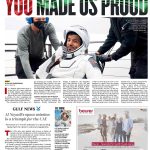There’s an unexpected twist to an age-old story in America.
Taylor Swift fans have taken to creating and selling goods inspired by her music and style – even sending special gifts for particularly creative supporters of the pop star!
Stay informed with the latest news in an easily-digestible format by subscribing to The Week’s twice daily news digests.
1. Scientists Discover a Second Giant Jawbone
A second jawbone from a giant oceanic titan has been discovered on a beach in Somerset, England by a father-and-daughter team. Paleontologists have identified it as belonging to an all-new species of giant ichthyosaur that lived two meters ago and measured at least that long.
Justin Reynolds and Ruby Reynolds, then 11 at the time, discovered a chunk of jawbone while searching for fossils on Blue Anchor beach in 2020. Together with fossil collector Paul de la Salle and study co-author Dean Lomax as well as study co-author Dean Lomax they proceeded to hunt for more pieces, uncovering sections of lower jawbone known as surangular. Altogether these bones show that this ichthyosaur measured 25 meters – equivalent to two buses nose-to-nose!
2. Pregnancy May Carry a Cost
Politics have been front and center, yet other stories have made headlines as well. Some are noteworthy – for instance, NFL officials signed an experienced quarterback to Chicago that may become franchise-caliber.
Others are more modest, such as the finding that women in large employer-sponsored private health insurance plans bear a substantial financial burden when giving birth. Although this information may come as no surprise to those familiar with pregnancy costs, it bears repeating in light of debate surrounding emergency contraception provision by pharmacists.
3. A Black Hole Is the Largest in the Milky Way
Astronomers have discovered an immense stellar black hole that rests at the centre of our Milky Way galaxy, boasting 33 times greater mass than our Sun.
Discoveries were made through analysis of stars orbiting some three thousand light years away in Aquila constellation using data from European Space Agency’s Gaia telescope. This revealed an unpredictable wobbling movement of one star that suggested it may have been tugged by something nearby.
Researchers examined data and discovered it was being pulled by an immense black hole with 33 times the mass of our star. It’s the biggest known object, though there could be hundreds of them throughout our galaxy.
4. Land Subsidence Is Overlooked as a Hazard in Cities
Recent years have brought greater focus to sea level rise and its possible ramifications; however, a study from Virginia Tech highlights an equally serious threat: land subsidence.
Land around major cities is sinking at an unprecedented pace, compounding climate change-induced flooding effects and exacerbating flooding risks. Subsidence causes coastal areas to sink while pushing up parts of the ocean floor which accelerate sea-level rise faster than predicted by most models.
Cities that stop groundwater withdrawal have found that restricting groundwater withdrawal has had significant beneficial results on subsidence reduction or cessation in Osaka and Tokyo. Nicholls and Manoochehr Shirzaei urge cities to move beyond quantifying problems to devising actionable strategies for mitigating them.
5. A New Breakthrough Could Revolutionise Medical and Material Engineering
Scientists have created an innovative molecular device that may make developing smart materials and medical treatments simpler. By employing force to regulate multiple molecules’ release at once, this groundbreaking molecule-releasing mechanism may transform material engineering, smart medicine and robotics applications alike.
Medical device engineers face one of their greatest challenges in selecting materials capable of meeting all their specifications, often limited by what standard materials offer them.
As an example, wound healing systems must encourage skin growth and blood vessel formation; bone replacement material must encourage cell attachment and spur bone growth. Medical-grade alternatives to standard materials can provide this performance while digital tools which incorporate biocompatibility early into design can eliminate trial-and-error while speeding up qualification processes.






